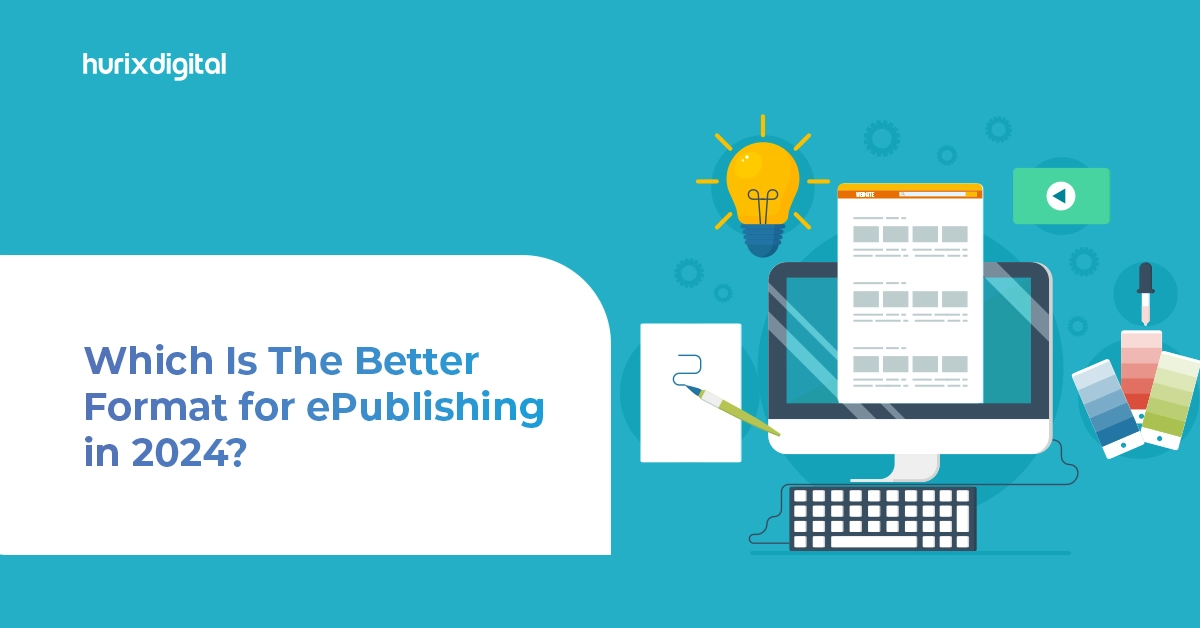
Which Is The Better Format for ePublishing in 2024?
Summary
This article compares different ePublishing formats, helping you choose the best one for your content based on factors like flexibility, accessibility, and user experience.
Are you in the publishing industry and wondering which is the better format for e-publishing in 2024? If your answer to this question is yes, you are at the right place.
After the global pandemic of COVID-19, the e-publishing industry has grown rapidly. The expected market size of digital publishing is to become $67.86 billion by 2027.
As a self-publishing author or a digital publisher, now is the right time to reconsider your publishing strategies and options.
All publishers, big or small, are now looking for the best format for e-publishing. Which is the better format for e-publishing depends on many factors like target audience, size of the book, formatting of the book, genre, web accessibility, and much more.
Before we begin to discuss which is the better format for e-publishing in 2024, let us first look into some common e-book formats to help you make an informed choice.
Common eBook Formats
1. EPUB
- This is an open standard format developed by the International Digital Publishing Forum (IDPF).
- It is designed specifically for e-books and is widely supported by e-readers, tablets, and smartphones.
- EPUB is a responsive format, which means that the text adjusts to fit the screen size of the device on which it is being read.
2. MOBI
- This is a format developed by Amazon for use with their Kindle e-reader devices.
- MOBI files can also be read on other devices using the Kindle app.
- MOBI files do not support as many formatting options as EPUB but support features such as bookmarks and annotations.
3. PDF
- This is a file format developed by Adobe Systems in the 1990s.
- PDF files can be read on almost any device, including desktop computers, laptops, tablets, and smartphones.
- PDF preserves the formatting of the original document, including images, fonts, and layout.
4. AZW
- This is a proprietary format developed by Amazon for use with their Kindle e-reader devices.
- AZW files are based on the MOBI format but contain additional features such as support for Amazon’s DRM (Digital Rights Management) system.
5. iBooks
- This is a format developed by Apple for use with their iBooks app.
- iBooks files can contain multimedia content such as videos and animations, and they can be read on iPhones, iPads, and Mac computers.
6. HTML
- This is a markup language used to create web pages. HTML files can be used to create e-books that can be read on a variety of devices using a web browser.
- HTML e-books can include multimedia and interactive content, but they do not support as many formatting options as EPUB or PDF.
7. TXT
- This is a simple text file format that can be used for e-books.
- TXT files do not support formatting or multimedia content, but they can be read on almost any device using a text editor or e-reader app.
- TXT files are often used for public-domain books that have been digitized.
However, out of all the formats, two formats stand out the most in 2024, PDF and EPUB. Let us discuss both formats in more detail.
PDF Format
PDF stands for Portable Document Format. It is a file format developed by Adobe Systems in the 1990s and is widely used for electronic documents.
PDF documents can be read on almost any device, including desktop computers, laptops, tablets, and smartphones. One of the main benefits of PDF is that it preserves the original document’s formatting, including images, fonts, and layout.
PDF is a popular format for e-publishing because it allows publishers to create digital versions of their printed material. This means publishers can repurpose their existing content without redesigning it for digital platforms.
PDFs are also easy to create using software such as Adobe Acrobat or Microsoft Word.
However, one major drawback of PDF is that it is not a responsive format. This means that the document does not adjust to fit the screen size of the device on which it is being read.
This can make reading PDFs on mobile devices challenging, as users may need to zoom in to read the text.
Additionally, PDFs do not support interactive features such as videos, animations, or hyperlinks.
EPUB Format
EPUB stands for Electronic Publication. It is a file format designed specifically for e-books. EPUB is an open standard format used on various devices, including e-readers, tablets, and smartphones.
One of the benefits of EPUB is that it is a responsive format, which means that the text adjusts to fit the screen size of the device on which it is being read.
EPUB also supports interactive features such as videos, animations, and hyperlinks. This makes it an ideal format for e-books that contain multimedia content.
Additionally, EPUB allows publishers to create dynamic content that can be updated in real-time. This means that readers can access the most up-to-date content without having to download a new version of the book.
One of the drawbacks of EPUB is that it can be more challenging to create than PDF. Publishers need specialized software to create EPUB files, and the format requires a significant investment of time and resources.
Additionally, EPUB files can be larger than PDF files, making them slower to download.
Which Format is Better for e-Publishing in 2024?
When it comes to e-publishing in 2024, the answer to which is the better format for e-publishing depends on the type of content being published.
For text-heavy content, such as fictional novels and K-12 education textbooks, PDF is the better format. PDF preserves the layout and formatting of the original document, which can make reading on large screens easier.
However, EPUB is the better format for content that contains multimedia elements, such as e-books with videos and animations. EPUB supports interactive features, which can enhance the reading experience for users.
Additionally, EPUB is a responsive format, which means it adapts to the size of the device on which it is being read.
Another factor to consider is the platform on which the content will be published. EPUB is the better format if the content will be primarily distributed through e-readers.
However, if the content will be distributed through various platforms, including desktop computers and mobile devices, then PDF is the better format.
Ultimately, the decision depends on the goals of the publisher and authors, along with the target audience’s needs.
Closing Thoughts
If you are still confused about which format to choose, do not worry. You can reach out to us at HurixDigital. We are a leading digital content solutions platform with a wide and reputable client base.
We can easily help you expand your digital publishing capabilities quickly and efficiently. Some other services we offer are K-12 content solutions, animation and video services, business analysis, and more.
Contact our experts now and get started!

Vice President – Digital Content Transformation. He is PMP, CSM, and CPACC certified and has 20+ years of experience in Project Management, Delivery Management, and managing the Offshore Development Centre (ODC).



